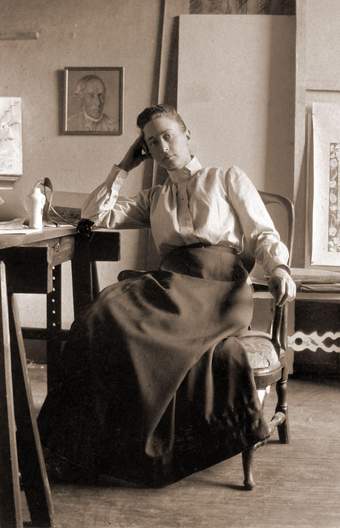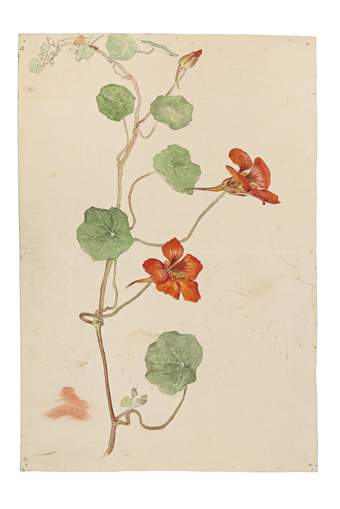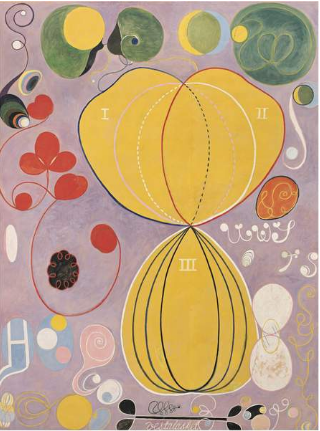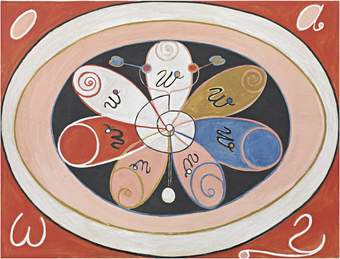
Hilma af Klint (1862-1944) in her studio, circa 1895. © Science History Images/ Alamy Stock Photo
Do you ever think about the mysteries of the universe? Or, have you ever made up a secret code for you and your friends? Well, you might have something in common with Swedish artist Hilma af Klint! Hilma is well known for being one of the first abstract artists in Europe. Abstract means not showing recognisable things like people, objects or landscapes in art. Instead, you can break a picture down into different elements - for instance lines or shapes! Hilma’s colourful, patterned paintings were pretty radical at the time.
So, where did she start?
Born in the village of Solna, Sweden in 1862, Hilma grew up taking summer holidays with her family on the island of Adelsö. Her father, who loved nature, taught her all about different animals and plants that lived there. Hilma would later keep journals and make detailed drawings of the wildflowers she saw - what do you think of the one below? She also worked briefly as an assistant in a school for vets! Her fascination with organic life fed into her artwork, and she became inspired by different patterns, especially spirals like the ones found on shells!

Hilma af Klint, Botanical Drawing c.1890. Courtesy Hilma af Klint Foundation
When it was time for her to leave school, Hilma got a place at the Royal Academy of Fine Arts in Sweden. This path was unusual as lots of countries didn’t admit girls into universities, but Sweden was one of the few that did. Hilma did well in her studies and was given a studio space by the university. She began to earn money from the landscape and portrait paintings she did.
Despite the independence being able to work gave her, Hilma soon started to move away from these kind of paintings. The tradition in Europe was to paint things realistically - or exactly as our eyes might see them. But for Hilma, this was missing a whole layer! How something looked was one thing - but what about its meaning, or how it made you feel? In 1906, she started creating oil paintings showing swirling colourful forms. Although other artists, like Wassily Kandinsky and Piet Mondrian, became famous for pioneering this abstract style, it’s likely Hilma was actually doing this a few years before them!

Hilma af Klint, Group IV The Ten Largest, No.7, Adulthood, 1907 . Courtesy of The Hilma af Klint Foundation
So, why did she choose this style?
Well - there are lots of reasons! One was that she was interested in the symbolic, or the meaning behind things. In her diary, Hilma wrote that using symbols in her art was a way of searching for ‘the essence…the soul of anything’. She used the colour green to show harmony - and spirals meant growth! Over time, she developed a detailed system of signs and messages. Hilma was also a very spiritual person. She formed a group with some friends who called themselves ‘The Five’. Together, they would try and talk to ghosts! Spooky, eh? But for Hilma, these meetings were about much more than getting a fright - it was a chance to share ideas about art and life with like-minded people.
Another influence on Hilma’s artwork could have been the technological advancements of the time - it was an exciting period when scientists and mathematicians were discovering things like x-rays, atoms and soundwaves! Hilma recognised that despite being taught in different ways, art and science were tools people used to explore the unknown and create meaning out of the world around them!

Hilma af Klint, The Evolution, The WUS Seven-Pointed Star Series, Group IV, No.15, 1908. Courtesy Hilma af Klint Foundation
In 1906 she started her Paintings for the Temple series. She described this as ‘the one great task I carried out in my lifetime’. When it was complete, the series was made up of 193 artworks! Phew. These paintings connected to Hilma’s beliefs, and she imagined they would one day be displayed in a temple where people could go and worship surrounded by art. In these paintings she used symbols to show opposites - from light and dark, ideas and matter. Although we might not see these things as direct opposites today, Hilma was attempting to show that everything is connected - even things which at first seem really different! This bright artist shows us a way of looking that includes lots of different ideas; from art, science, religion and nature.
Can you think of a few different subjects you're interested in? How do you think they connect together?

